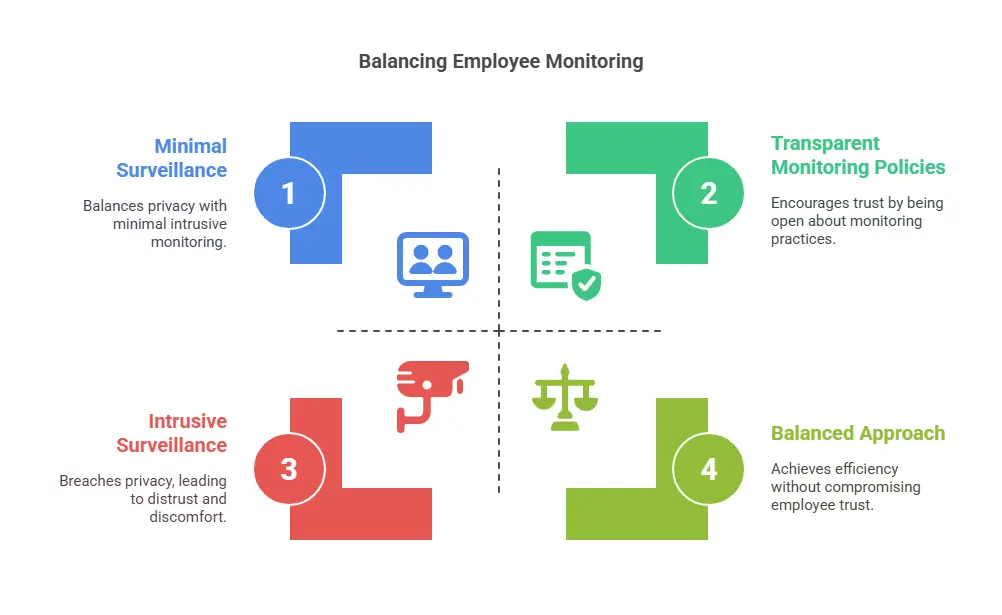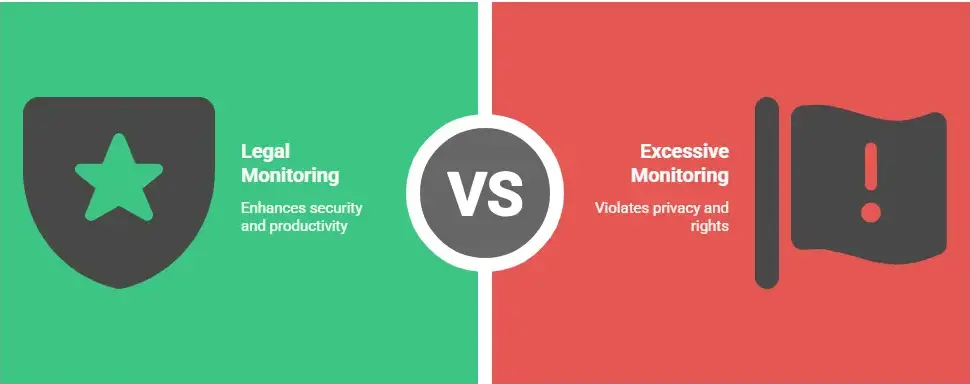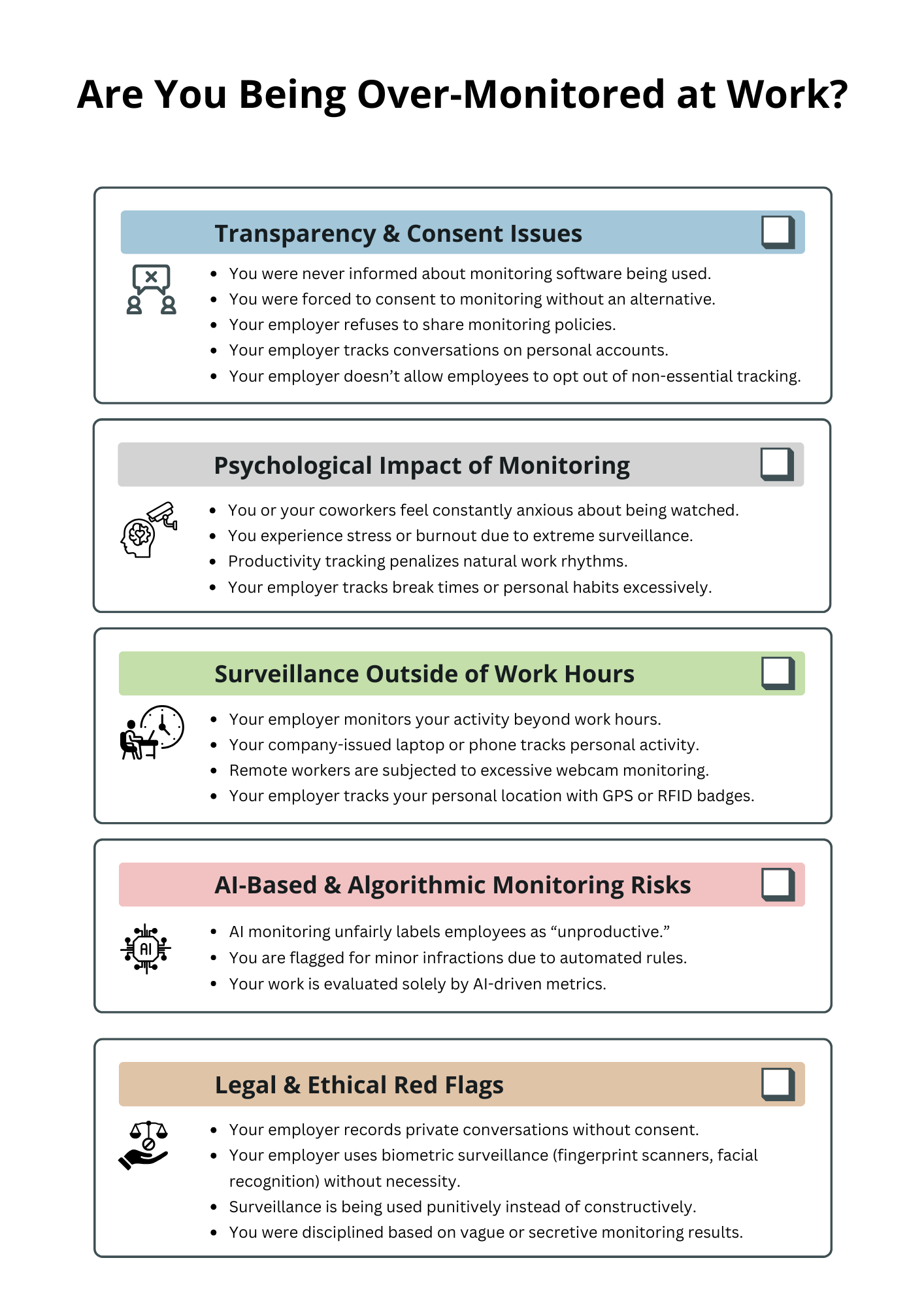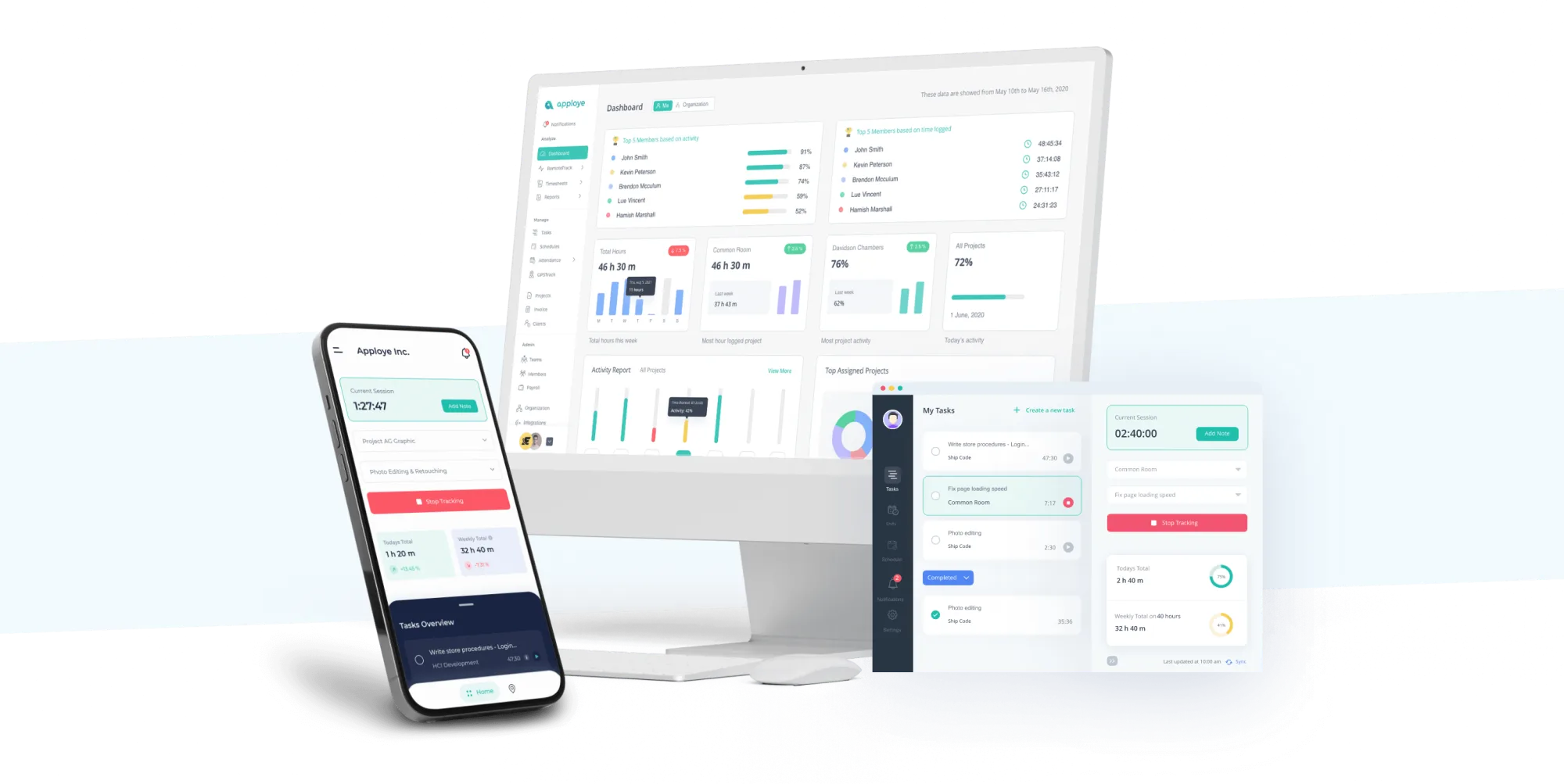Employee Monitoring Ethics: What’s Legal, Fair, and What’s Not

Key Summary:
-
Excessive surveillance creates stressed employees who distrust management—monitored workers are 49% more likely to pretend to work.
-
Legal boundaries vary: EU requires consent, California gives data rights, US federal law allows monitoring on company devices with significant loopholes.
-
Ethical monitoring focuses on improvement not punishment, respects work hours, and maintains transparency about what's tracked and why.
Imagine walking into your office, logging into your computer, and knowing that every keystroke, mouse movement, employee emails, and even personal communications are being tracked by employee monitoring software.
Would you feel more productive employee or just paranoid?
While business owners argue that employee monitoring systems improve employee productivity, prevent security breaches, and mitigate potential threats, workers worry about the expectation of privacy, stress, and a lack of employee trust.
So where’s the ethical line? How much employee monitoring is too much? And does monitoring of employees increase employee performance, or does it just create a hostile work environment?
Here we’ll analyze employee monitoring technology and its impact, exploring legal compliance, best practices, and ethical implications. This will ensure a balanced approach to workplace surveillance.
In this article
- Monitoring ethics & dilemmas
- The hidden costs of excessive surveillance
- What happens when you break the law
- The right (and wrong) employee monitoring tools
- What the experts say about ethical monitoring
- How to monitor employees ethically and legally
The Ethical Dilemma of Employee Monitoring

Productivity vs. Privacy: Do Employers Own Your Work Time?
One of the most pressing ethical questions in employee monitoring policy is: Do employees sacrifice their rights to privacy when they sign a work contract? Do they still have a reasonable expectation of privacy while using company computers?
Employers often track employee activity to prevent unauthorized access, detect suspicious activity, and ensure operational compliance with privacy laws.
However, when company policies become too restrictive, employees might feel their dignity is compromised.
Too much electronic surveillance leads to an unhealthy company culture where employees feel pressured, untrusted, and dehumanized. This negatively affects employee experience, team morale, and overall employee acceptance of monitoring.
Trust vs. Surveillance: Does Tracking Build Efficiency or Destroy Morale?
One of the paradoxes of employee monitoring practices is that while it aims to enhance employee performance, it can also undermine employee trust if executed improperly.
- The Erosion of Trust: Studies show that excessive video surveillance and intrusive forms of tracking lead to negative impacts such as stress, job dissatisfaction, and disengagement.
- The "Chilling Effect": People who feel watched all the time take fewer chances. This kills new ideas and stops good changes from happening.
- Surveillance Overload: Some companies go too far by monitoring digital work activity, tracking even remote employees and remote workers outside working hours.
Survey found that employees under constant surveillance are 49% more likely to pretend to work while doing non-work activities.
AI Bias & Workplace Fairness: Can Algorithm-Driven Monitoring Lead to Discriminatory Practices?
AI-powered employee monitoring solutions raise legal repercussions, especially regarding fairness in performance evaluation.
- Flawed Algorithms: AI monitoring may inaccurately assess individual employees, punishing those who aren’t constantly typing but are still working productively.
- Unfair Evaluations: People in customer service, HR, or management talk to people a lot. AI trackers don't count this as work, so these workers get judged unfairly.
- Discriminatory Monitoring: Bias in monitoring AI may lead to issues of employee monitoring, particularly against minority workers.
Real-World Cases of Unethical Monitoring Practices
Case 1. Woolworths Group – 100% AI Efficiency vs. Dignity of Employees
Woolworths stores in Australia have implemented AI-driven employee monitoring methods to maximize efficiency in their warehouses. However, this resulted in mental strain and exhaustion, violating the ethical boundaries of employee well-being.
Workers had to wear headsets that told them what to do. The system checked if they were 100% efficient.
This system made workers' bodies and minds feel bad. Many got hurt because they felt rushed. Also, the strict rules made them worry about getting hurt. For this, 1,500 warehouse workers went on strike. [Source: The Guardian]
Trying to be super-efficient without thinking about how workers feel can make people quit and cause legal troubles.
Case 2. Amazon – High Productivity but Increased Stress & Worker Injuries
Amazon’s monitoring policies increased security threat awareness, but at the cost of extreme workplace pressure. And this led to a hostile work environment.
Amazon uses lots of monitoring in its warehouses. They use tools to track workers' productivity and efficiency. These rules made work very tough. Workers felt more stressed, and some got hurt. [Source: CNBC]
Monitoring can make work get done faster, but when employees feel watched like machines, they get burned out and quit.
Case 3. Topgolf – Time Tracking Backfired with Legal Consequences
Topgolf implemented fingerprint scanning to track employees with access to sensitive areas. However, the company faced lawsuits under employee monitoring laws.
Later, workers sued the company because of the Illinois Biometric Information Privacy Act (BIPA). This shows the legal dangers of monitoring workers too much.
Worker surveillance must follow legal rules. If not, even simple time-tracking could end up in court.
What Does the Law Say About Ethical Monitoring?
Laws regarding monitoring activities vary across jurisdictions. While some protect expectations of privacy, others allow broad employer surveillance. So, not having the same rules everywhere often makes things unclear.
GDPR (EU) – Employee Consent and Data Protection
The General Data Protection Regulation (GDPR) sets the gold standard for data privacy in the European Union. Under GDPR, businesses must obtain consent from employees before monitoring employee communications.
Primary requirements for employers under GDPR:
- Transparency: Employers must tell workers what info they collect, how they'll use it, and who can see it.
- Purpose Limitation: Data can only be gathered for clear, good reasons and can't be used for other things.
- Minimization Principle: Employers should only collect data necessary for business operations, avoiding excessive surveillance.
- Right to Access & Deletion: Workers can ask for a copy of their data and ask to have it deleted when it's not needed anymore.
H&M was fined €35 million in Germany for unlawfully monitoring employees, showing how serious GDPR penalties can be.
CCPA (California) – Privacy Rights of Employees
The California Consumer Privacy Act (CCPA) extends privacy rights to employees working in California-based companies or businesses handling California residents' data.
How CCPA protects employees from excessive monitoring:
- Employees must be told before any data is collected.
- Workers have the right to say no to unnecessary data processing.
- Companies must share what personal data they collect and how they use it.
ECPA (US) – Limits on Electronic Monitoring
The Electronic Communications Privacy Act (ECPA) (1986) governs electronic workplace surveillance in the United States. But because it's old, many new ways of monitoring workers fall into gray areas.
The ECPA regulates email monitoring, allowing tracking of activity on company devices but limiting covert invasion of privacy.
Here are the main provisions under the ECPA:
- Employers can monitor electronic communications (emails, phone calls, messages) on company-owned devices for business purposes.
- The "Business Purpose Exception" allows monitoring without employee consent if it's deemed necessary for workplace operations.
- The "Consent Exception" enables monitoring if employees provide explicit or implied consent (often through workplace policies).
Ethical Concern: The ECPA does not prevent covert surveillance of employees. This makes US workplace monitoring laws less employee-friendly than GDPR or CCPA.
ILO (International Labour Organization) Guidelines on Workplace Privacy
The International Labour Organization (ILO) provides a strategic approach to the ethics of employee monitoring, ensuring a positive work environment. It creates non-binding guidelines advocating for:
- Not going overboard with workplace watching.
- Keeping workers' privacy as safe as possible.
- Strong data security to stop misuse of worker info.
Employee Rights & Employer Responsibilities When it Comes to Monitoring

Legal vs. Excessive Employee Monitoring Practices
Not all monitoring efforts are unethical, but excessive tracking raises ethical implications.
So, monitoring employees for security, compliance, and productivity is legal. However, in most jurisdictions, over-monitoring can violate employee rights.
What Constitutes Excessive Workplace Monitoring?
- Secret electronic surveillance of employee computer activity.
- Tracking remote employees after hours.
- AI-based micromanagement without transparent communication
- Using tools that unfairly penalize workers for "idle time."
- Surveilling employees' personal devices or social media without permission.
How Businesses Can Stay Compliant
To avoid legal risks and ethical concerns, companies should:
- Define objectives for employee monitoring clearly.
- Obtain employee consent.
- Limit data collection to legitimate business purposes.
- Provide employees access to their data.
- Ensure ethical surveillance tools rather than covert tracking.
Ethical vs. Invasive Employee Monitoring Software
- Microsoft Workplace Analytics (workflow insights)
- Apploye (time tracking with transparency)
- Teramind (security-first monitoring)
- Bossware (stealth surveillance software)
- Keystroke loggers
- Automated webcam monitoring
Ethical Employee Monitoring Tools
Apploye
Focus: Employee monitoring and time tracking with consent.
Why It’s Ethical: Employees control their own data; businesses get time-based productivity insights.
Features that Make Apploye an Ethical Employee Monitoring Software
Apploye keeps track of your work in a nice way that respects your privacy. Here's how it does that:
- Customizable Activity Tracking Settings: Managers can pick what they want to track, like screen monitoring or website & app usage tracking. This way, they only see what they need to see.
- Screenshot Notes: You can add notes to explain your screenshots. This gives you a chance to tell your side of the story.
- Permission-Based Instant Screenshots: Apploye has the option to ask for your permission before taking screenshots instead of just doing it without telling you.
- Individual Tracking Exemptions: Your company can turn off tracking for certain people if they don't need to be monitored.
- Active & Neutral Time Analytics: Instead of calling all non-active time "unproductive", Apploye knows the difference between active work and just taking a break.
- Focus on Productivity Ratio: The system looks at how much you get done, not just how much you're being observed.
- Idle Time Management: Apploye can tell the difference between taking a break and being inactive. It handles these breaks fairly.
- Manual Time Entry Options: Allows employees to manually log time with notes explaining entries. And managers can approve or decline it.
- Time Off Management: The system handles vacation time in a way that respects your need for breaks.
- Weekly Reports by Email: You get clear updates on how you're doing each week.
- Multiple Reporting Views: The app offers various perspectives (project-wise, member-wise) for a fairer assessment of work.
- Privacy-first: Apploye doesn't track your keystrokes or use other creepy tracking methods.
Any remote or in-office team can easily adopt Apploye to monitor employees and simplify workload management without micromanaging employees.
Microsoft Workplace Analytics
Focus: Organizational productivity insights.
Why It’s Ethical: It uses aggregate data to analyze work patterns without invasive tracking.
Features:
- Analyze team collaboration, email overload, and meeting efficiency.
- Provides actionable insights to optimize workflows.
- Helps avoid burnout by identifying overworking trends.
A financial services firm can utilize workplace analytics to identify meeting overload, reduce unnecessary calls, and boost efficiency.
Teramind
Focus: Security-first monitoring with privacy safeguards.
Why It’s Ethical: Customizable settings allow businesses to monitor only security risks without invading privacy.
Features:
- AI-powered anomaly detection prevents insider threats.
- Data loss prevention (DLP) protects sensitive business information.
- Monitors only work-related tasks, not personal activities.
A healthcare company can confidently use Teramind to secure patient data. It ensures compliance with HIPAA regulations while avoiding unnecessary employee surveillance.
Practical Solutions: Ethical Alternatives to Over-Monitoring
Companies are using more software to monitor workers these days. This makes many people worry about privacy and trust. Instead of spying on employees, companies should try ways that help workers do better without watching their every move.
Shift from Keystroke Tracking to Project-Based KPIs
When employers track every click and keystroke, workers get scared and stressed. This makes them less happy at work. Some might even start breaking the rules because they feel too controlled.
Alternative Approach:
- Focus on outcome-based KPIs instead of monitoring every minute.
- Track performance by results, not screen activity.
- Let people work toward goals in their own way.
Empower Employees with Self-Tracking Tools
Monitoring workers all the time makes them feel you don't trust them. A better idea is to give workers the tools to track their own productivity.
Better Approach:
- Give workers access to their own work data so they can get better.
- Use tools that help spot when someone might be getting too tired.
- Notice and praise when workers improve on their own.
Adopt Ethical Monitoring Tools Focused on Security, Not Micromanagement
Traditional employee surveillance software watches every little thing workers do. This makes them upset and untrusting. Instead, organizations should use better tools that focus on keeping things safe and improving workflow.
Better Approach:
- Use security-based monitoring instead of tracking all activity.
- Be transparent. Employees should know what’s monitored and why.
- Leverage AI-driven insights for workflow optimization.
How to Tell If Your Employer Is Over-Monitoring You
Keeping an eye on workers is normal these days, but there's a line between ethical tracking and invasive surveillance. Bosses might say monitoring boosts productivity, which is true.
But too much can hurt trust, make people stressed, and create a bad place to work.
Use this checklist to see if your employer is crossing the line with workplace tracking:

If you checked 2 or more boxes, you are likely being over-monitored.
What to Do If You’re Being Over-Monitored
- Request Clarity: Ask HR about monitoring activities.
- Know Your Rights: Consult a law firm specializing in workplace monitoring.
- Report Issues: Address security issues and potential threats.
- Seek Legal Guidance: If tracking is excessive, explore legal repercussions.
Expert Perspectives: Ethical Employee Monitoring Done Right
Watching employees at work needs to be done carefully. Organizations want to keep an eye on workers, but they need privacy, too. Experts in surveillance ethics say good monitoring means being open about it, respecting workers' choices, and following fair rules.
Ken Cox on Privacy Concerns in Employee Monitoring
Ken Cox, the President of Hostirian, a leading data privacy firm, talks about the problems with monitoring workers too much:
"The ethical considerations surrounding electronic monitoring in the workplace cannot be overstated. Although illegal, employees have reported hidden cameras in restrooms, and employers now even track personal computer files, the extent of monitoring has reached alarming levels."
Cox says that excessive surveillance can make workers stop trusting their bosses. This can make people feel bad at work, and then they might not work as well.
Michael Brown on Balancing Monitoring and Privacy
Michael Brown, Vice President of Technology at Auvik, talks about finding the right mix between monitoring employees and giving them space:
"The evident tension between employee monitoring and personal privacy makes it imperative for companies to find and maintain an appropriate balance that upholds critical visibility while respecting boundaries and adhering to data privacy laws."
Brown thinks corporations should have clear rules about what they watch and why they watch it. This way, the monitoring stays fair and follows the law.
Best Practices for Ethical Employee Monitoring
Balancing workplace transparency, privacy, and productivity is essential for an ethical employee monitoring tool. Poorly managed monitoring creates distrust and reduces morale.
The following best practices ensure fairness while maintaining efficiency.
Transparency: Clearly Communicate Monitoring Policies
Employees don’t like workplace monitoring when it’s implemented secretly. This lack of transparency leads to mistrust and lower engagement.
Best Practices
- Clearly state what is monitored, why, and how.
- Ensure policy access via onboarding docs and HR portals.
- Hold leaders accountable for ethical monitoring practices.
- Encourage open discussions about monitoring concerns.
Consent & Compliance: Ensure Employees Are Aware
While many countries legally permit employee monitoring, ethical considerations go beyond legality. Ethical monitoring requires active employee consent and follows privacy laws like GDPR & ECPA.
Best Practices
- Obtain written consent before implementing monitoring.
- Follow legal frameworks like GDPR and ECPA.
- Monitor only company devices to avoid privacy violations.
- Clearly separate work and personal device usage.
Minimal & Necessary Monitoring: Avoid Excessive Surveillance
Over-monitoring signals distrust, reduces morale, and increases counterproductive behaviors (e.g., cyberloafing, time theft). Excessive tracking also discourages creativity and autonomy.
Best Practices
- Track only essential work-related activities.
- Avoid selective monitoring to prevent bias.
- Retain monitoring data only as long as necessary.
- Disable tracking outside work hours.
Data Protection: Secure and Anonymize Collected Data
Monitoring programs generate massive amounts of sensitive data. So, if misused, it can breach employee privacy and lead to security risks.
Best Practices
- Encrypt monitoring data and restrict access.
- Anonymize reports where possible.
- Avoid personal data collection (e.g., private messages).
- Conduct regular audits to ensure compliance.
Alternative Productivity Strategies: Self-Reporting & Ethical Analytics
Ethical monitoring shouldn’t replace employee engagement. Instead of invasive tracking, organizations can use self-reporting and ethical analytics to boost productivity.
Best Practices
- Encourage self-reporting instead of constant tracking.
- Set clear KPIs rather than monitoring every keystroke.
- Let employees access their own productivity reports.
- Track workload balance, not just activity levels.
Case Studies: Companies Doing It Right
Douglas Academy Improved Productivity by 28% with Apploye Employee Monitoring

Douglas Academy is a school in Canada that teaches kids about robots and coding. They had a hard time keeping track of their teachers because many worked online or at different schools. They trusted their teachers, but they had no way to know if they were showing up or teaching well.
That's when Mohammad D., the school’s director, decided to use Apploye monitoring and time tracking. It helped by:
- Keeping track of teachers' work hours.
- Taking random pictures of online classes to check if lessons were good.
- Checking how much work teachers were doing to make sure everything was fair.
The results were amazing! In less than a year, productivity improved by 28%! The school got more done while still trusting its teachers.
This shows that monitoring employees in a fair way helps everyone do their best without making them feel like they are being watched all the time.
How Apploye Time Tracker Helped LOUD & Spacecaps Stay on Track & Boost Productivity
Matt H., co-founder of LOUD & Spacecaps, needed an easy way to remember project deadlines. He also wanted to stay focused and not get distracted by small tasks. So, he tried Apploye, and it worked really well!
This tool helped Matt and his team stay on time. It broke big jobs into smaller steps and reminded them to take short breaks. It also made sure they finished important work first before worrying about little things.
Matt didn’t have to check on his team all the time. With the app, he could quickly see how things were going. It also helped everyone focus by cutting down on office distractions.
In the end, Matt found Apploye helpful and not too expensive. It kept his projects on track and made work easier!
Conclusion: The Path to Ethical Employee Monitoring
Overly strict company policies on monitoring can lead to negative impacts on employee experience. However, an ethical boundaries approach fosters employees who are accountable, engaged, and productive.
Moving forward, companies must choose between invasion of privacy and a positive work environment. The best path is clear: a balanced, ethical, and compliant approach to workplace monitoring.
As technology gets better, businesses have a choice: control or collaboration? The future of work should be built on trust, not spying.

